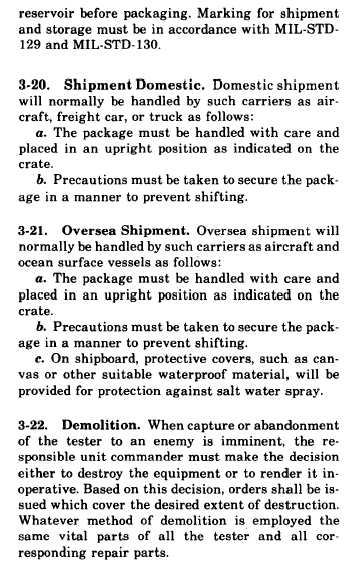|
| |
3-20.
3-21.
3-22.
TM 55-4920-400-13
sledge hammers, crowbars, picks, axes, or any other
heavy tools which may be available to destroy the
following:
(1) Instruments.
(2) Control knobs.
(3) Accessories.
b. Demolition by Misuse. Perform the follow-
ing steps to render the tester inoperative.
(1) Break the glass on the oil reservoir and
run the tester until failure occurs.
(2) Run the tester and turn the selector knobs
quickly from one position to another.
3-24. Other Demolition Methods.
a. Scattering and Concealment. Remove the
accessories from the cover compartment and scatter
them through dense foliage, bury them in dirt and
sand or throw them in lake, stream or other body of
water.
b. Burning. Pack rags, clothing or canvas under
and around the unit and inside the unit at the front
and rear. Saturate this packing with gasoline, oil, or
diesel fuel and ignite.
Do not allow an open flame within 50
feet when using gasoline; remove the
container from the area, and ignite
from a distance.
c. Submersion. Totally submerge the unit in a
body of water to provide water damage and con-
cealment. A body of salt water will do greater dam-
age to metal parts than submersion in a body of
fresh water.
3-23. Demolition to Render Tester Inoperative.
a. Demolition by Mechanical Means. Use
Section VII.
ILLUSTRATED PARTS
3-25. General. This Illustrated Parts Breakdown
lists and describes the parts for the Pitot and Static
Systems Tester Assembly, part number S6-21312,
manufactured by Satellite Engineering & Sales Co.,
Inc., North Hollywood, California.
a. The Group Assembly Parts List (page 3-14-3-
3-25), consists of the complete Tester Assembly di-
vided into six groups, consisting of major assem-
blies and subassemblies. Each assembly listed is fol-
lowed immediately by its component parts properly
indented thereunder to show their relationship to
the assembly.
b. Parts are listed in the Part No. column by
their manufacturer’s or government part number
BREAKDOWN
c. The quantities listed in the “Units per Assy”
column of the Group Assembly Parts List are, in the
case of assemblies, the total quantity used per as-
sembly at the location indicated, while the com-
ponent parts indented under the assemblies are the
quantity used per assembly. The quantities speci-
fied, therefore, are not necessarily the total used per
Tester Assembly. Refer to the Numerical Index
(page 3-26-3-32) for the total quantities used per
Tester.
3-26. Terms, Abbreviations and Symbols. At-
taching parts are listed immediately following the
part(s) they attach and have the same indentioni.
3-7
|

